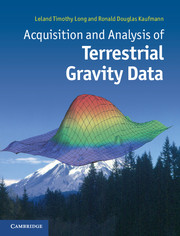Book contents
- Frontmatter
- Contents
- Preface
- 1 Gravitational attraction
- 2 Instruments and data reduction
- 3 Field acquisition of gravity data
- 4 Graphical representation of the anomalous field
- 5 Manipulation of the gravity field
- 6 Interpretation of density structure
- 7 The inversion of gravity data
- 8 Experimental isostasy
- A Appendix ACommon definitions and equations in potential theory
- B Appendix BGlossary of symbols
- References
- Index
8 - Experimental isostasy
Published online by Cambridge University Press: 05 February 2013
- Frontmatter
- Contents
- Preface
- 1 Gravitational attraction
- 2 Instruments and data reduction
- 3 Field acquisition of gravity data
- 4 Graphical representation of the anomalous field
- 5 Manipulation of the gravity field
- 6 Interpretation of density structure
- 7 The inversion of gravity data
- 8 Experimental isostasy
- A Appendix ACommon definitions and equations in potential theory
- B Appendix BGlossary of symbols
- References
- Index
Summary
The isostatic reduction
The complete Bouguer anomaly has the pronounced effect of removing the attraction of the mass between the point of observation and mean sea level or another convenient datum for reduction. In mountainous regions with an average elevation of 600 m the mass removed introduces Bouguer anomalies on the order of −67 mGal. According to the principle of isostasy, these negative Bouguer anomalies are attributed to the zones of anomalous negative mass below the datum that compensate and support the surface load. The thicker mountainous crust is in effect floating on the denser asthenosphere. In the isostatic reduction the surface mass is not removed as it is in the Bouguer anomaly. Instead, the surface mass is moved to below the datum of reduction. The free air reduction is equivalent to moving the mass into a thin layer at the surface, making the free air reduction a kind of isostatic reduction. In another sense, the isostatic reduction may be viewed as the removal of the topography and the removal of the compensating mass according to a particular model for the compensation. In general, the distribution of compensating mass is unknown. In this chapter we discuss the character of the relation between topography and the Bouguer gravity anomaly and the determination of the distribution of compensating mass.
The isostatic response function
The isostatic response function is an abstract quantity that cannot be measured directly. Conceptually, it is the Bouguer gravity anomaly resulting from the load of an unrealistic very narrow and tall mountain in isostatic equilibrium. Consequently, the isostatic response function can be a complicated consequence of the elastic strength and composition of the affected rocks. Also, over time, viscoelastic deformation of the underlying rocks, inelastic deformation like faulting, and elastic deformation under stress make the isostatic response function a complex function of time and tectonic history. The Pratt–Hayford and Airy–Heiskanen compensation models (see Chapter 2 and Heiskanen and Moritz, 1967) for computation of the isostatic anomaly illustrate classical models for the expected character of the isostatic response function. In Figure 8.1 a point load corresponding to these models of isostatic compensation is approximated by a 1.0-km high topographic feature with a width of 20 km. In Figure 8.2 the Bouguer anomaly, that is the approximated isostatic response function, for these two models are similar, supporting the observation that the isostatic anomaly computed using either of these two models is very similar.
- Type
- Chapter
- Information
- Acquisition and Analysis of Terrestrial Gravity Data , pp. 149 - 160Publisher: Cambridge University PressPrint publication year: 2013



